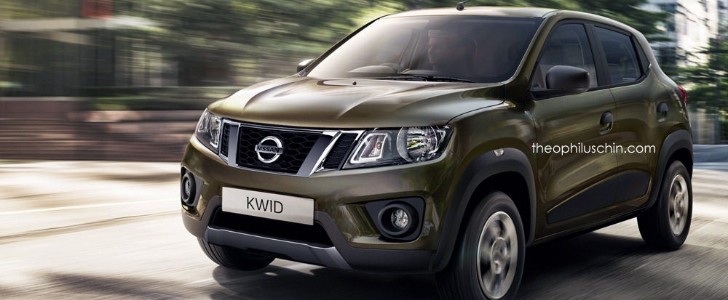Seeing that it had the potential to be a global success story, Renault rebranded the Dacia Duster as its own crossover. A few years after that, mister Ghosn gave the go-ahead for Nissan to make its badge-engineered version called the Terrano.
A much smaller and cheaper model called the Kwid was unveiled recently in production guise. It probably won't be sold in Europe, but would make a great little Nissan, appealing to customers who are unfriendly towards the French brand or don't have the right dealerships in the area.
That's what the rendering of the day shows us, a Nissan version of the Renault Kwid. All Nissan crossovers have a distinctive, tough look, defined by the wide V-shaped fascia. We think the photoshop treatment done by Theophilus Chin could be a great direction to travel if Nissan ever wants an A-segment car for the Indian market.
The Renault Kwid is built 97% percent using parts made in India, which means Nissan might have cheap parts on hand. Why would the sister firms want two of the same thing? Because the A segment in India accounts for 25% of the market or 750,000 units annually. If the marketing makes sense, profits can be made.
Underneath the chunky body is the group's CMF-A (Common Module Family-Affordable) platform. How big is this thing? Much smaller than a Nissan Juke. It measures 3.68 meters from bumper to bumper and is only 1.58 meters wide, which means it can navigate the narrowest of streets.
Power comes from an engine that's much smaller than even Twingo customers are used to, a 0.8-liter naturally aspirated three-banger that develops 57 horsepower. Because there's less equipment installed (probably only one airbag), the power needed to motivate the Kwid is less than you'd expect.
That's what the rendering of the day shows us, a Nissan version of the Renault Kwid. All Nissan crossovers have a distinctive, tough look, defined by the wide V-shaped fascia. We think the photoshop treatment done by Theophilus Chin could be a great direction to travel if Nissan ever wants an A-segment car for the Indian market.
The Renault Kwid is built 97% percent using parts made in India, which means Nissan might have cheap parts on hand. Why would the sister firms want two of the same thing? Because the A segment in India accounts for 25% of the market or 750,000 units annually. If the marketing makes sense, profits can be made.
Underneath the chunky body is the group's CMF-A (Common Module Family-Affordable) platform. How big is this thing? Much smaller than a Nissan Juke. It measures 3.68 meters from bumper to bumper and is only 1.58 meters wide, which means it can navigate the narrowest of streets.
Power comes from an engine that's much smaller than even Twingo customers are used to, a 0.8-liter naturally aspirated three-banger that develops 57 horsepower. Because there's less equipment installed (probably only one airbag), the power needed to motivate the Kwid is less than you'd expect.

